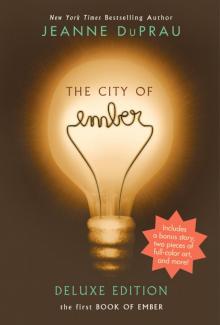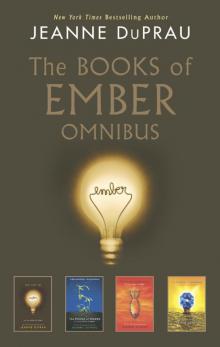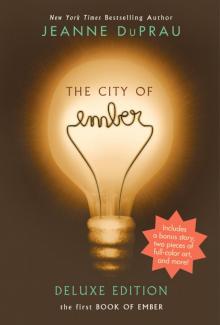- Home
- Jeanne DuPrau
The City of Ember
The City of Ember Read online
The Books of Ember
THE CITY OF EMBER
THE PEOPLE OF SPARKS
THE PROPHET OF YONWOOD
THE DIAMOND OF DARKHOLD
This is a work of fiction. Names, characters, places, and incidents either are the product of the author’s imagination or are used fictitiously. Any resemblance to actual persons, living or dead, events, or locales is entirely coincidental.
Text copyright © 2003 by Jeanne DuPrau
Introduction and “On the Day of the Bombs” copyright © 2013 by Jeanne DuPrau
All rights reserved.
Published in the United States by Random House Children’s Books, a division of Random House, Inc., New York.
Originally published in hardcover in the United States in slightly different form by Random House Children’s Books, New York, in 2003.
Random House and the colophon are registered trademarks of Random House, Inc.
Full-color interior art consists of an image of the original cover of The City of Ember, designed by Chris Riely, and an image by Niklas Asker from The City of Ember: The Graphic Novel, copyright © 2012 by Niklas Asker. The image from The City of Ember: The Graphic Novel is used by permission of the illustrator.
Explore Ember at BooksofEmber.com!
Visit us on the Web! randomhouse.com/kids
Educators and librarians, for a variety of teaching tools, visit us at RHTeachersLibrarians.com
The Library of Congress has cataloged the non-deluxe edition of this work as follows:
DuPrau, Jeanne. The city of Ember / by Jeanne DuPrau.
p. cm.
Summary: In the year 241, twelve-year-old Lina trades jobs on Assignment Day to be a messenger, to run to new places in her beloved but decaying city, perhaps even to glimpse Unknown Regions.
[1. Fantasy.] I. Title. PZ7.D927 Ci 2003 [Fic]—dc21 2002010239
eISBN: 978-0-385-37136-0
Cover design and map by Chris Riely
Random House Children’s Books supports the First Amendment and celebrates the right to read.
v3.1
Cover
Other Books by This Author
Title Page
Copyright
Map
Introduction to the Deluxe Edition
The Instructions
1. Assignment Day
2. A Message to the Mayor
3. Under Ember
4. Something Lost, Nothing Found
5. On Night Street
6. The Box in the Closet
7. A Message Full of Holes
8. Explorations
9. The Door in the Roped-Off Tunnel
10. Blue Sky and Goodbye
11. Lizzie’s Groceries
12. A Dreadful Discovery
13. Deciphering the Message
14. The Way Out
15. A Desperate Run
16. The Singing
17. Away
18. Where the River Goes
19. A World of Light
20. The Last Message
Acknowledgments
On the Day of the Bombs
Excerpt from The People of Sparks
Dear Readers,
Many years ago, the image of a city appeared in my mind—a city that was only a faltering spot of light in a vast darkness. I hadn’t been thinking about cities, especially, or about darkness. This image, which felt intriguing and powerful, came as a surprise. As it turned out, it was the first in a long series of surprises that marked the story of The City of Ember—both the writing of the book and its progress in the world.
I was about halfway through the first draft of The City of Ember when I came across another surprise. I discovered to my chagrin that writing a novel was far harder than I’d expected it to be. Over the course of my life I’d read thousands of novels. Shouldn’t I know how to write one? I wondered. But I struggled with The City of Ember for years before I finally got it right. I still have ancient drafts of it at the bottom of my closet. There’s a version in which the mayor has a wife. There’s one with a long section that takes place in the storerooms. Many of the characters have different names in these early versions. Doon, for instance, was once named Willet. Sometimes, as I wrote and crossed out what I’d written and rewrote time and again, I wasn’t sure I’d ever make it to the end.
But I did, and then came the next surprise, which I liked much better than the previous one. I’d always known that it wasn’t easy to get a book published. Even writers who had gone on to become famous often received piles of rejections before the acceptance finally came. But I had the great good fortune to find, almost right away, an agent who liked my book. Then she found an editor who liked it, too, and that agent and that editor have been a joy to work with ever since.
More surprises followed. There happened to be an artistic genius at Random House just at the time my book needed a cover. He designed the glowing light bulb with the wire that spelled out “ember.” It is dark but still faintly glimmering, like the city itself.
The book came out in 2003, and it soon found an audience, one which was different in some ways from what I’d expected. When I’d imagined boys and girls reading The City of Ember, I’d pictured them sitting at home nestled in an armchair, with a lamp beaming down and rain falling in a cozy way outside. I certainly hope that happens. But—surprise!—kids also read Ember in schools. To this day I get letters from whole classes that have read it. I also hear from schools that stage an Ember Day, with a lottery and jobs and science projects in which kids make generators. Like Doon in The City of Ember, students are learning to find ingenious solutions to their world’s problems; like Lina, they’re exercising their imaginations and thinking about the future.
Then there was the movie. That was a staggering surprise. I got to see my city through someone else’s eyes. While it wasn’t my vision of Ember, it was a strange and fascinating vision of its own. Bill Murray made a delightfully sleazy mayor!
And of course there are the three other Ember books. You might not think they’d be a surprise—hadn’t I had them in mind from the beginning? The answer is no. I hadn’t planned on writing them at all. I was going to say goodbye to Lina and Doon and Poppy up there in the hills above Ember, by themselves, looking out on the beautiful world, and leave what happened next to the reader’s imagination. But the story had an unexpected pull on me. Somehow, it demanded to keep going.
Now there’s the graphic novel, drawn by an artist whose vision is so close to my own that he almost seems to have visited Ember and gotten to know its streets and buildings and people. How did he manage that? Once again—I’m astonished.
Best of all is that so many readers, of all ages and in all different countries, have loved the story of Ember. What more could a writer want? That has been a truly wonderful way to be surprised.
Most gratefully yours,
Jeanne DuPrau
When the city of Ember was just built and not yet inhabited, the chief builder and the assistant builder, both of them weary, sat down to speak of the future.
“They must not leave the city for at least two hundred years,” said the chief builder. “Or perhaps two hundred and twenty.”
“Is that long enough?” asked his assistant.
“It should be. We can’t know for sure.”
“And when the time comes,” said the assistant, “how will they know what to do?”
“We’ll provide them with instructions, of course,” the chief builder replied.
“But who will keep the instructions? Who can we trust to keep them safe and secret all that time?”
“The mayor of the city will keep the instructions,” said the chief builder. “We’ll put them in a box with a timed lock, set to open on the proper date.”
“And will we tell the mayor what’s in the box?” the assistant asked.
“No, just that it’s information they won’t need and must not see until the box opens of its own accord.”
“So the first mayor will pass the box to the next mayor, and that one to the next, and so on down through the years, all of them keeping it secret, all that time?”
“What else can we do?” asked the chief builder. “Nothing about this endeavor is certain. There may be no one left in the city by then or no safe place for them to come back to.”
So the first mayor of Ember was given the box, told to guard it carefully, and solemnly sworn to secrecy. When she grew old, and her time as mayor was up, she explained about the box to her successor, who also kept the secret carefully, as did the next mayor. Things went as planned for many years. But the seventh mayor of Ember was less honorable than the ones who’d come before him, and more desperate. He was ill—he had the coughing sickness that was common in the city then—and he thought the box might hold a secret that would save his life. He took it from its hiding place in the basement of the Gathering Hall and brought it home with him, where he attacked it with a hammer.
But his strength was failing by then. All he managed to do was dent the lid a little. And before he could return the box to its official hiding place or tell his successor about it, he died. The box ended up at the back of a closet, shoved behind some old bags and bundles. There it sat, unnoticed, year after year, until its time arrived, and the lock quietly clicked open.
In the city of Ember, the sky was always dark. The only light came from great flood lamps mounted on the buildings and at the tops of poles in the middle of the larger squares. When the lights were on, they cast a yellowish glow over the streets; people walking by threw long shadows that shortened and then stretched out again. When the lights were off, as they were between nine at night and six in the morning, the city was so dark that people might as well have been wearing blindfolds.
Sometimes darkness fell in the middle of the day. The city of Ember was old, and everything in it, including the power lines, was in need of repair. So now and then the lights would flicker and go out. These were terrible moments for the people of Ember. As they came to a halt in the middle of the street or stood stock-still in their houses, afraid to move in the utter blackness, they were reminded of something they preferred not to think about: that someday the lights of the city might go out and never come back on.
But most of the time life proceeded as it always had. Grown people did their work, and younger people, until they reached the age of twelve, went to school. On the last day of their final year, which was called Assignment Day, they were given jobs to do.
The graduating students occupied Room 8 of the Ember School. On Assignment Day of the year 241, this classroom, usually noisy first thing in the morning, was completely silent. All twenty-four students sat upright and still at the desks they had grown too big for. They were waiting.
The desks were arranged in four rows of six, one behind the other. In the last row sat a slender girl named Lina Mayfleet. She was winding a strand of her long, dark hair around her finger, winding and unwinding it again and again. Sometimes she plucked at a thread on her ragged cape or bent over to pull on her socks, which were loose and tended to slide down around her ankles. One of her feet tapped the floor softly.
In the second row was a boy named Doon Harrow. He sat with his shoulders hunched, his eyes squeezed shut in concentration, and his hands clasped tightly together. His hair looked rumpled, as if he hadn’t combed it for a while. He had dark, thick eyebrows, which made him look serious at the best of times and, when he was anxious or angry, came together to form a straight line across his forehead. His brown corduroy jacket was so old that its ridges had flattened out.
Both the girl and the boy were making urgent wishes. Doon’s wish was very specific. He repeated it over and over again, his lips moving slightly, as if he could make it come true by saying it a thousand times. Lina was making her wish in pictures rather than in words. In her mind’s eye, she saw herself running through the streets of the city in a red jacket. She made this picture as bright and real as she could.
Lina looked up and gazed around the schoolroom. She said a silent goodbye to everything that had been familiar for so long. Goodbye to the map of the city of Ember in its scarred wooden frame and the cabinet whose shelves held The Book of Numbers, The Book of Letters, and The Book of the City of Ember. Goodbye to the cabinet drawers labeled “New Paper” and “Old Paper.” Goodbye to the three electric lights in the ceiling that seemed always, no matter where you sat, to cast the shadow of your head over the page you were writing on. And goodbye to their teacher, Miss Thorn, who had finished her Last Day of School speech, wishing them luck in the lives they were about to begin. Now, having run out of things to say, she was standing at her desk with her frayed shawl clasped around her shoulders. And still the mayor, the guest of honor, had not arrived.
Someone’s foot scraped back and forth on the floor. Miss Thorn sighed. Then the door rattled open, and the mayor walked in. He looked annoyed, as though they were the ones who were late.
“Welcome, Mayor Cole,” said Miss Thorn. She held out her hand to him.
The mayor made his mouth into a smile. “Miss Thorn,” he said, enfolding her hand. “Greetings. Another year.” The mayor was a vast, heavy man, so big in the middle that his arms looked small and dangling. In one hand he held a little cloth bag.
He lumbered to the front of the room and faced the students. His gray, drooping face appeared to be made of something stiffer than ordinary skin; it rarely moved except for making the smile that was on it now.
“Young people of the Highest Class,” the mayor began. He stopped and scanned the room for several moments; his eyes seemed to look out from far back inside his head. He nodded slowly. “Assignment Day now, isn’t it? Yes. First we get our education. Then we serve our city.” Again his eyes moved back and forth along the rows of students, and again he nodded, as if someone had confirmed what he’d said. He put the little bag on Miss Thorn’s desk and rested his hand on it. “What will that service be, eh? Perhaps you’re wondering.” He did his smile again, and his heavy cheeks folded like drapes.
Lina’s hands were cold. She wrapped her cape around her and pressed her hands between her knees. Please hurry, Mr. Mayor, she said silently. Please just let us choose and get it over with. Doon, in his mind, was saying the same thing, only he didn’t say please.
“Something to remember,” the mayor said, holding up one finger. “Job you draw today is for three years. Then, Evaluation. Are you good at your job? Fine. You may keep it. Are you unsatisfactory? Is there a greater need elsewhere? You will be re-assigned. It is extremely important,” he said, jabbing his finger at the class, “for all … work … of Ember … to be done. To be properly done.”
He picked up the bag and pulled open the drawstring. “So. Let us begin. Simple procedure. Come up one at a time. Reach into this bag. Take one slip of paper. Read it out loud.” He smiled and nodded. The flesh under his chin bulged in and out. “Who cares to be first?”
No one moved. Lina stared down at the top of her desk. There was a long silence. Then Lizzie Bisco, one of Lina’s best friends, sprang to her feet. “I would like to be first,” she said in her breathless high voice.
“Good. Walk forward.”
Lizzie went to stand before the mayor. Because of her orange hair, she looked like a bright spark next to him.
“Now choose.” The mayor held out the bag with one hand and put the other behind his back, as if to show he would not interfere.
Lizzie reached into the bag and withdrew a tightly folded square of paper. She unfolded it carefully. Lina couldn’t see the look on Lizzie’s face, but she could hear the disappointment in her voice as she read out loud: “Supply Depot clerk.”
“Very good,” said the mayor. “A vital job.”
Lizzie trudged back to her
desk. Lina smiled at her, but Lizzie made a sour face. Supply Depot clerk wasn’t a bad job, but it was a dull one. The Supply Depot clerks sat behind a long counter, took orders from the storekeepers of Ember, and sent the carriers down to bring up what was wanted from the vast network of storerooms beneath Ember’s streets. The storerooms held supplies of every kind—canned food, clothes, furniture, blankets, light bulbs, medicine, pots and pans, reams of paper, soap, more light bulbs—everything the people of Ember could possibly need. The clerks sat at their ledger books all day, recording the orders that came in and the goods that went out. Lizzie didn’t like to sit still; she would have been better suited to something else, Lina thought—messenger, maybe, the job Lina wanted for herself. Messengers ran through the city all day, going everywhere, seeing everything.
“Next,” said the mayor.
This time two people stood up at once, Orly Gordon and Chet Noam. Orly quickly sat down again, and Chet approached the mayor.
“Choose, young man,” the mayor said.
Chet chose. He unfolded his scrap of paper. “Electrician’s helper,” he read, and his wide face broke into a smile. Lina heard someone take a quick breath. She looked over to see Doon pressing a hand against his mouth.
You never knew, each year, exactly which jobs would be offered. Some years there were several good jobs, like greenhouse helper, timekeeper’s assistant, or messenger, and no bad jobs at all. Other years, jobs like Pipeworks laborer, trash sifter, and mold scraper were mixed in. But there would always be at least one or two jobs for electrician’s helper. Fixing the electricity was the most important job in Ember, and more people worked at it than at anything else.
Orly Gordon was next. She got the job of building repair assistant, which was a good job for Orly. She was a strong girl and liked hard work. Vindie Chance was made a greenhouse helper. She gave Lina a big grin as she went back to her seat. She’ll get to work with Clary, Lina thought. Lucky. So far no one had picked a really bad job. Perhaps this time there would be no bad jobs at all.

 The Prophet of Yonwood
The Prophet of Yonwood The City of Ember
The City of Ember The Books of Ember Omnibus
The Books of Ember Omnibus The Diamond of Darkhold
The Diamond of Darkhold Voyagers: Escape the Vortex (Book 5)
Voyagers: Escape the Vortex (Book 5) The City of Ember Deluxe Edition
The City of Ember Deluxe Edition The People of Sparks: The Second Book of Ember (Books of Ember)
The People of Sparks: The Second Book of Ember (Books of Ember) The People of Sparks
The People of Sparks Escape the Vortex
Escape the Vortex Car Trouble
Car Trouble The City of Ember: The First Book of Ember
The City of Ember: The First Book of Ember